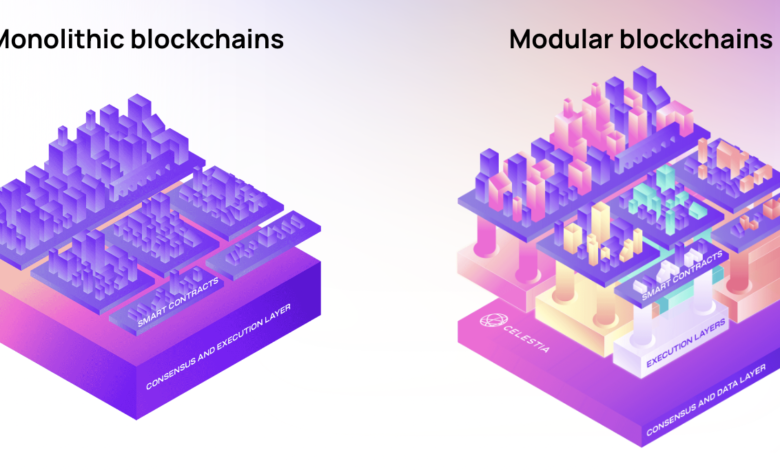Celestia Labs Raises $55M In A Combined Series A & B Round

Founders of the Celestia blockchain network, Celestia Labs, have raised $55 million in a combined Series A and B investment sponsored by venture capital firms Polychain Capital and Bain Capital Crypto.
According to a person familiar with the situation, the money raising elevated Celestia to unicorn status with a $1 billion valuation and was four times oversubscribed.
Coinbase Ventures, Jump Crypto, FTX Ventures, Placeholder, Galaxy, Delphi Digital, and several additional venture capital and angel investors were also participants in the round. Previously, in March of last year, Celestia secured $1.5 million in a seed round at an undisclosed valuation.
With a focus on “modular” blockchain networks, Celestia Labs, a 2019 startup, is redefining blockchain architecture. The company claims this approach makes building and expanding blockchains simpler.
The only goal of the layer one blockchain Celestia is to arrange transactions and make the data for transactions accessible. Smart contracts and computations are not handled or carried out on the blockchain. Instead, as part of its flexible, modular design, Celestia’s concept outsources these tasks to roll-ups or other blockchains.
Monolithic blockchains like Ethereum or Solana, which have had trouble with scalability and outages, have dominated the crypto world so far.
Mustafa Al-Bassam, the co-founder of Celestia Labs, says, “For the past decade, cryptocurrency has been stifled by an unending circle of new monolithic [layer 1] smart contract platforms, each racing to the bottom to forsake decentralization and security to deliver reduced transaction costs.” Within the limitations of a monolithic framework, Web3 cannot scale.
According to Celestia, a modular blockchain avoids the trilemma that usually afflicts monolithic blockchains by allowing the primary operations of blockchains – consensus, settlement, data availability, and execution – to be detached into different layers.
The Celestia network allows developers to mix and match various types of infrastructure while still maintaining interoperability while creating Web3 applications.
Across the decentralized application stack, modular designs are enabling quick experimentation, according to Bain Capital Crypto partner Alex Evans in a statement. Celestia “offers better abstractions for developers and greater sovereignty for communities of users” by reducing base-layer complexity.
Although Celestia has yet to reveal a token, it launched its test net in May 2022.
The functions that modular blockchains can specialize in are:
- Execution: Processes transactions.
- Settlement: Dispute resolution and bridge (optional).
- Consensus: Orders transactions.
- Data availability: Ensures data is available.
While crude versions of modular stacks were initially introduced with rollups, a new stack of purpose-built modular blockchains can be employed to benefit from this new paradigm rather than scaling monolithic chains.
A modular blockchain known as rollups focuses on execution, offloading consensus, settlement, and data availability to other levels. Another modular blockchain, Celestia, focuses on consensus and data accessibility while offloading performance to different chains, such as rollups.
In contrast to earlier blockchain ideas, Celestia’s fundamental capability is not execution. Since blockchains may be constructed for unique purposes because of their modularity, implementation is unnecessary because a different chain can handle it. Doing this removes the biggest monolithic chain bottlenecks—transaction execution and state bloat—from the base layer.
Layer 1 blockchain A step closer to becoming the first fully functional modular blockchain, Celestia has launched its “Mamaki” test net, the firm announced on Wednesday.
By isolating consensus from execution, modular networks enable users to rapidly create their blockchains while upholding the security norms of competing tier 1s.
A rising issue with networks like Ethereum is state execution bottlenecking, which is avoided by blockchains placed on the web thanks to Celestia’s decision not to do its transaction validation.
Benefits of Modular Blockchains
Sovereignty
Using other layers, new modular blockchains can be sovereign like layer 1s. As a result, the blockchain may respond to hacks and push updates without approval from any underlying layers. Blockchains using Celestia would be able to do this because it won’t place any limitations on them. One of the most significant features of blockchains as social coordinating mechanisms is that they preserve the potential for a social agreement to make critical decisions.
Launching new blockchains
New blockchains can use existing modular blockchains for the components they desire to offload because modular blockchains don’t have to handle all functionalities. This makes it possible to efficiently bootstrap new blockchains, cutting down on deployment time and expense. For instance, using the Cosmos SDK and a rollup “SDK” like Optimint will make it easier to create new blockchains without needing to bootstrap a safe validator set.
Scalability
Blockchains that are modular are not limited by having to handle every function. Scaling is possible without compromising security or decentralization by dividing them onto several tiers. As a result, a decentralized, multi-chain environment is consistent with sustainable blockchain scalability.
According to a press release, the project — backed by venture capital firm NFX, Cosmos creator Zaki Manian, and a small group of others — thinks its technology could put an end to the “monolithic era” of layer one competition by offering a solution that is ultimately more autonomous and scalable for mass adoption.
“This will alter how anyone scaling Web 3 projects may do it. Almost everything has implications here, from NFTs to gaming, according to Ekram Ahmed of Celestia Labs, who spoke with CoinDesk. “Our main net will launch in early 2023, although we are still in the early stages.”
Celestia crypto
Mustafa Al-Bassam, a well-known hacktivist, and developer, detained by the FBI in 2011 when he was 16 years old, founded Celestia.
According to a news release, users can operate nodes, receive test net tokens, delegate to validators, and transfer transactions between wallets on the Mamaki test net (named after the Hawaiian beverage).
The blockchain’s incentive test net, unveiled closer to the project’s main net next year and rewards users with tokens for engagement, is not Mamaki, according to Celestia.




